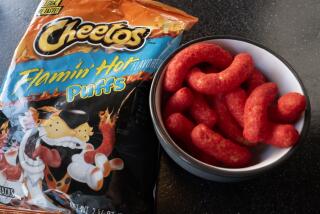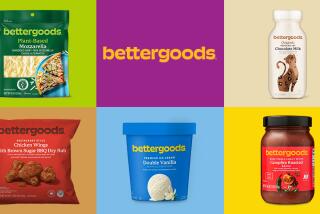Fast Food Off the Shelf : Taco Bell and Frito-Lay Will Take Mexican Fare Into Supermarkets
- Share via
IRVINE — Taco Bell and Frito-Lay will venture into the nation’s supermarket aisles this spring with a line of products designed to capture part of the rapidly growing Mexican foods market.
In May, the two companies--both owned by soft-drink giant Pepsico Inc. in Purchase, N.Y.--will test-market a line of Taco Bell brands at grocery stores in Ohio and Georgia. Taco Bell and Frito-Lay might eventually expand the line for sale through convenience and warehouse stores.
Pepsico is betting that consumers will embrace the new products because of Taco Bell’s strong image as a purveyor of low-cost but tasty fast food. Taco Bell, based in Irvine, reported $3.3 billion in worldwide sales last year. But Pepsico also is banking on Frito-Lay to develop the marketing and distribution muscle needed to expand beyond its conventional line of snack foods, such as Lay’s potato chips and Doritos corn chips.
Taco Bell and Frito-Lay are entering one of the nation’s fastest-growing food segments, according to Packaged Facts in New York. Grocery store sales of Mexican foods will double to $4 billion for 1997, up from $2.2 billion for 1992, the market research concern predicts.
The expansion from fast-food restaurants to supermarket shelves “seems like a smart move,” said Don Beaver, president of the California Grocers Assn. in Sacramento. “Taco Bell and Frito-Lay have tremendous name identification, and if they handle it right, it could be really effective.”
The two Pepsico subsidiaries face stiff competition for shelf space as supermarkets are being swamped with new items. Nearly 62,000 products were introduced between 1987 and 1991, according to the Food Marketing Institute in Washington.
The two may have a competitive edge, however, because “companies like Taco Bell have established substantial brand franchises,” said Willard Bishop, a supermarket consultant based in Chicago. While name recognition will help, Bishop said, Taco Bell and Frito-Lay must “prove they can deliver good-tasting food at a competitive price.”
And no matter how good or well-priced the product, the venture won’t succeed unless the foods find their way to grocers’ shelves.
Frito-Lay, based in Plano, Tex., uses a proprietary, direct-store delivery system to stock the nation’s supermarket shelves daily with fresh snacks. That system accounted for 90% of the company’s $4 billion in 1992 retail sales.
Direct delivery works well with perishable items, but it runs counter to the warehouse system that grocery stores have developed to keep their shelves stocked.
Frito-Lay recently created a new division that can ship products directly into retailers’ warehouses, said Don Knauss, Frito-Lay vice president. That system “initially is targeted at grocery stores,” Knauss said. “But we’re looking at other classical channels of distribution (leading to) the mass merchandisers and convenience stores.”
If the Taco Bell line proves to be successful, Knauss said, Frito-Lay might eventually distribute similar products produced by two other Pepsico subsidiaries: Pizza Hut and Kentucky Fried Chicken.
New in Supermarket From Taco Bell
THE TACO BELL DINNER KIT * Twelve taco shells * Seasoning mix * Taco sauce
OTHER TACO BELL ITEMS * Taco shells (12 and 18 count) * Refried beans (16 and 30 ounces) * Salsa (mild, medium, hot) * Picante sauce (mild, medium, hot) * Salsa verde * Salsa con queso * Taco sauce (mild, medium, hot) * White corn tortilla chips
Source: Taco Bell
Carving Out a New Niche on Crowded Store Shelves
Taco Bell will have its hands full fighting for already congested shelf space as it joins forces with Frito-Lay, a sister company owned by Pepsico Inc., to produce, package and market a new line of Mexican food products to be sold at grocery stores.
Where New Products Debut
Supermarkets remained the most popular venue for introducing a new product in 1992, up from 59% in the year before. Supermarket: 63% Gourmet shops: 24% Health food store: 13%
More New Products
Though the introduction of new products nationally was flat in 1992, introductions have risen 59% since 1988. 1992: 16,790
What’s New?
Health and beauty products topped last year’s list of new products. Manufacturers avoided truly “new” breakthrough concepts, which can be risky, opting instead to extend tried-and-true lines with additions such as new flavors.
Health and beauty care 22.0% 3,690 Condiments 15.2% 2,555 Candy, gum, snacks 12.3% 2,068 Beverages 9.2% 1,538 Bakery foods 9.0% 1,508 Dairy 7.9% 1,320 Other* 24.4% 4,111
* Others include items such as baby food, cereals, entrees, pet foods and household supplies.
New-Product Chronology
In 1992, three of four new products introduced were food items. But the number of non-food offers is gaining; they increased nearly 20% last year compared to 1991.
Food Products
1988 1989 1990 1991 1992 Baby food 55 53 31 95 53 Bakery products 968 1,155 1,239 1,631 1,508 Baking ingredients 212 233 307 335 346 Beverages 936 913 1,143 1,367 1,538 Breakfast cereal 97 118 123 108 122 Candy, gum, snacks 1,310 1,355 1,468 1,885 2,068 Condiments 1,608 1,701 2,028 2,787 2,555 Dairy 854 1,348 1,327 1,111 1,320 Desserts 39 69 49 124 93 Entrees 613 694 753 808 698 Fruits, vegetables 262 214 325 356 276 Pet food 100 126 130 202 179 Processed meat 548 509 663 798 785 Side dishes 402 489 538 530 560 Soup 179 215 159 265 211 Total, food 8,183 9,192 10,283 12,402 12,312
Non-Food Products
1988 1989 1990 1991 1992 Health, beauty care 2,000 2,308 2,379 3,064 3,690 Household supplies 233 372 317 423 474 Paper products 100 121 174 165 153 Tobacco products 12 29 31 19 45 Pet products 30 33 42 74 116 Total, non-food 2,375 2,863 2,943 3,745 4,478 Total new products 10,458 12,055 13,226 16,147 16,790
Sources: Food Marketing Institute, New Product News magazine;
Researched by GREG JOHNSON and DALLAS M. JACKSON / Los Angeles Times
More to Read
Inside the business of entertainment
The Wide Shot brings you news, analysis and insights on everything from streaming wars to production — and what it all means for the future.
You may occasionally receive promotional content from the Los Angeles Times.










